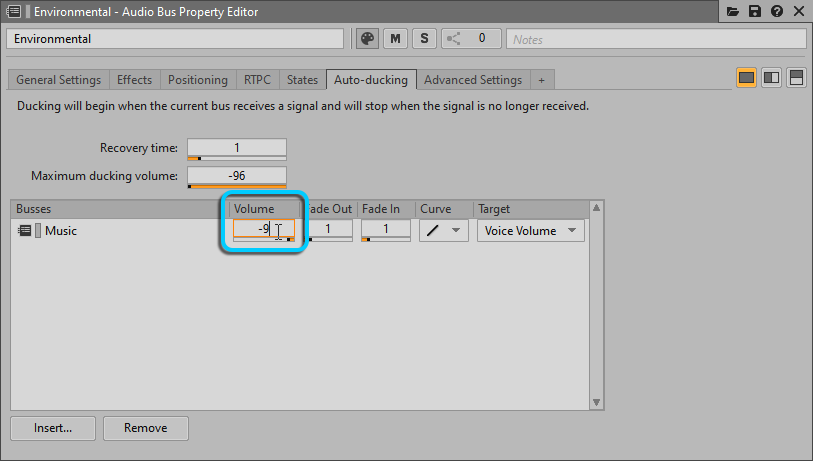Table of Contents
-
-
-
-
-
-
-
-
-
-
-
-
Ducking
-
-
-
-
-
-
-
An advantage of creating specific Audio Busses for different types of sounds, is that you can create dynamic relationships between those busses. One of the most common examples of this is called Ducking. Ducking is a way to make the volume of one audio signal path change depending on the volume of another audio signal path. A classic example of this is with radio DJs. When they talk into their microphone, the presence of signal on the microphone is used to automatically turn down the music so the DJ’s voice can more easily be heard. When the DJ stops talking, the music is automatically turned back up.
Ducking is a powerful feature in game audio and this feature, available on Audio Busses, is very easy to set up. In this case, you’ll duck the volume of music when there’s action in the game and you want to make sure the player hears the sounds you’ve worked so hard to integrate. However, there are going to be times when the player just wants to hide out in a corner, standing still so there aren’t any environmental sounds to be heard. In that case, you’ll make the music come up in volume just a bit.
You start by choosing the bus whose audio volume you want to use to control another bus.
-
In the Master-Mixer Hierarchy, choose the Environmental Bus.

Now you need to designate which bus you want to control with the Environmental Bus.
-
In the Auto-ducking tab, click Insert.

The Project Explorer - Browser window opens.

-
Expand the Master Audio Bus, select Music, and click OK.
You now need to indicate how the volume of the Music bus will be affected when there's an audio signal on the Environmental bus. The default Volume change is -6 dB, which is where volume changes just begin to become noticeable. You’ll exaggerate the volume change just a bit more.
-
Set the Volume property to -9.

There are other properties such as Fade In and Fade Out that determine how much time passes between when a signal is detected on the bus, and the act of modifying the target bus occurs. The Target column currently indicates that the volume change is applied to the Voice Volume, which means volume is subtracted from the Voice Volume property of each of the objects that contribute to the Music bus. However, the Target can be changed to Bus Volume, in which case the volume change would affect the bus's overall level.